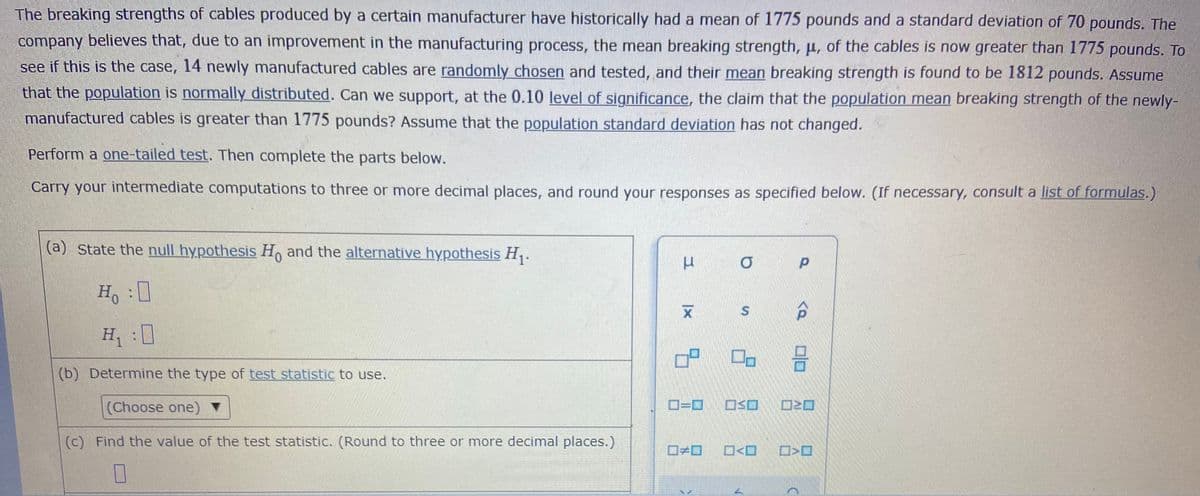he breaking strengths of cables produced by a certain manufacturer have historically had a mean of 1775 pounds and a standard deviation of 70 pounds. The company believes that, due to an improvement in the manufacturing process, the mean breaking strength, µ, of the cables is now greater than 1775 pounds. To see if this is the case, 14 newly manufactured cables are randomly chosen and tested, and their mean breaking strength is found to be 1812 pounds. Assume that the population is normally distributed. Can we support, at the 0.10 level of significance, the claim that the population mean breaking strength of the newly- manufactured cables is greater than 1775 pounds? Assume that the population standard deviation has not changed. Perform a one-tailed test. Then complete the parts below. Carry your intermediate computations to three or more decimal places, and round your responses as specified below. (If necessary, consult a list of formulas.) (a) State the null hypothesis H and the alternative hypothesis H. H, :0 H:0 (b) Determine the type of test statistic to use. (Choose one) ▼ OSO (c) Find the value of the test statistic. (Round to three or more decimal places.) O
he breaking strengths of cables produced by a certain manufacturer have historically had a mean of 1775 pounds and a standard deviation of 70 pounds. The company believes that, due to an improvement in the manufacturing process, the mean breaking strength, µ, of the cables is now greater than 1775 pounds. To see if this is the case, 14 newly manufactured cables are randomly chosen and tested, and their mean breaking strength is found to be 1812 pounds. Assume that the population is normally distributed. Can we support, at the 0.10 level of significance, the claim that the population mean breaking strength of the newly- manufactured cables is greater than 1775 pounds? Assume that the population standard deviation has not changed. Perform a one-tailed test. Then complete the parts below. Carry your intermediate computations to three or more decimal places, and round your responses as specified below. (If necessary, consult a list of formulas.) (a) State the null hypothesis H and the alternative hypothesis H. H, :0 H:0 (b) Determine the type of test statistic to use. (Choose one) ▼ OSO (c) Find the value of the test statistic. (Round to three or more decimal places.) O
MATLAB: An Introduction with Applications
6th Edition
ISBN:9781119256830
Author:Amos Gilat
Publisher:Amos Gilat
Chapter1: Starting With Matlab
Section: Chapter Questions
Problem 1P
Related questions
Question

Transcribed Image Text:Carry your intermediate computations to three or more decimal places, and round your responses as specified below. (If necessary, consult a list of for
(a) State the null hypothesis H, and the alternative hypothesis H1.
Ho :
H
,
(b) Determine the type of test statistic to use.
(Choose one) ▼
O=0 OSO O20
(c) Find the value of the test statistic. (Round to three or more decimal places.)
O>0 O<O _ D>O
(d) Find the p-value. (Round to three or more decimal places.)
(e) Can we support the claim that the population mean breaking strength of the
newly-manufactured cables is greater than 1775 pounds?
OYes ONo

Transcribed Image Text:The breaking strengths of cables produced by a certain manufacturer have historically had a mean of 1775 pounds and a standard deviation of 70 pounds. The
company believes that, due to an improvement in the manufacturing process, the mean breaking strength, u, of the cables is now greater than 1775 pounds. To
see if this is the case, 14 newly manufactured cables are randomly chosen and tested, and their mean breaking strength is found to be 1812 pounds. Assume
that the population is normally distributed. Can we support, at the 0.10 level of significance, the claim that the population mean breaking strength of the newly-
manufactured cables is greater than 1775 pounds? Assume that the population standard deviation has not changed.
Perform a one-tailed test. Then complete the parts below.
Carry your intermediate computations to three or more decimal places, and round your responses as specified below. (If necessary, consult a list of formulas.)
(a) State the null hypothesis H, and the alternative hypothesis H,.
Ho
H :0
믐
(b) Determine the type of test statistic to use.
(Choose one)
▼
O=D OSO
(c) Find the value of the test statistic. (Round to three or more decimal places.)
Expert Solution
This question has been solved!
Explore an expertly crafted, step-by-step solution for a thorough understanding of key concepts.
This is a popular solution!
Trending now
This is a popular solution!
Step by step
Solved in 3 steps with 2 images

Recommended textbooks for you

MATLAB: An Introduction with Applications
Statistics
ISBN:
9781119256830
Author:
Amos Gilat
Publisher:
John Wiley & Sons Inc

Probability and Statistics for Engineering and th…
Statistics
ISBN:
9781305251809
Author:
Jay L. Devore
Publisher:
Cengage Learning

Statistics for The Behavioral Sciences (MindTap C…
Statistics
ISBN:
9781305504912
Author:
Frederick J Gravetter, Larry B. Wallnau
Publisher:
Cengage Learning

MATLAB: An Introduction with Applications
Statistics
ISBN:
9781119256830
Author:
Amos Gilat
Publisher:
John Wiley & Sons Inc

Probability and Statistics for Engineering and th…
Statistics
ISBN:
9781305251809
Author:
Jay L. Devore
Publisher:
Cengage Learning

Statistics for The Behavioral Sciences (MindTap C…
Statistics
ISBN:
9781305504912
Author:
Frederick J Gravetter, Larry B. Wallnau
Publisher:
Cengage Learning

Elementary Statistics: Picturing the World (7th E…
Statistics
ISBN:
9780134683416
Author:
Ron Larson, Betsy Farber
Publisher:
PEARSON

The Basic Practice of Statistics
Statistics
ISBN:
9781319042578
Author:
David S. Moore, William I. Notz, Michael A. Fligner
Publisher:
W. H. Freeman

Introduction to the Practice of Statistics
Statistics
ISBN:
9781319013387
Author:
David S. Moore, George P. McCabe, Bruce A. Craig
Publisher:
W. H. Freeman